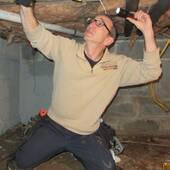While performing home inspections in New Jersey I come across factory built fireplaces almost on a daily basis. The factory built fire place has become a cost effective fireplace option for many new constructions and retro fit applications. The fireplace still remains a very important part of the home where people gather and find comfort. There are some differences between the newer factory built fireplace and the more traditional masonry fireplaces.
The traditional masonry fireplace is based on the theories of thermodynamics. The design of a restricted chimney opening to increase updraft was developed and thus the masonry chimney and fireplace was born. These drafting improvement allowed for fires to burn in the fireplace enclosure and not fill the room with smoke.
Factory-built fireplaces are very popular and now account for roughly 75% of all fireplace installs. A significant difference is that the factory built fire place is built offsite and then installed. The traditional masonry fireplace is built on site and is more labor intensive and has a much high cost. Thus the factory built option has been very popular with home builders.
A factory built fireplace consists of a firebox enclosed in a steel cabinet, and a steel chimney or flue. The factory built model is lightweight, cost effective, safe and very efficient. The factory built fire place can be installed easily on any level of the home. Pre-manufactured masonry fireplaces are also coming into their own but they are at a much higher cost and usually installed in very high end homes.
The Underwriters Laboratories and the American Gas Association established strict standards for factory built fireplaces. Factory-built fireplaces have a good safety record. However, there are some things to keep in mind in order to avoid the risk of fire.
If the factory built fireplace is installed on any combustible material, such as carpet or tile, the fire place must lay on a metal panel that extends the length and width of the appliance. Also any combustible floor covering near the fuel opening must be insulated with non combustible floor protection.
Room air intake and outlet vents must be unobstructed. The same fire safety precautions that are used for masonry fireplaces should also be used when using a factory built fireplace.
Regular maintenance and cleaning are required in order to ensure safe and efficient operation, similar to those used for a masonry fireplace.
The chimney liner and fireplace should be inspected monthly during the winter months in order to determine if creosote has built up. Creosote is the black oily substance that builds up as a result of incomplete combustion of wood materials. A professional chimney sweep should be contracted to properly clean out the unit and chimney at least once a year in order to help reduce fire hazards. Home inspectors in New Jersey should alert clients of creosote build up and the potential fire hazard the material creates. It should also be noted in the home inspection report.

Comments(1)